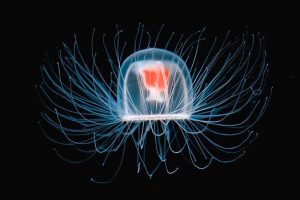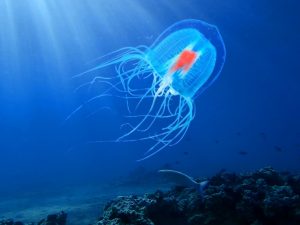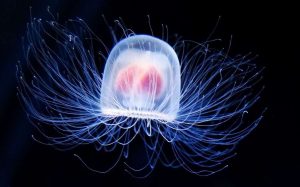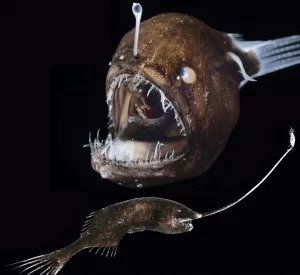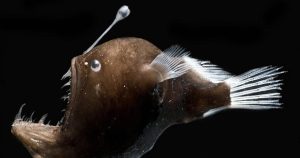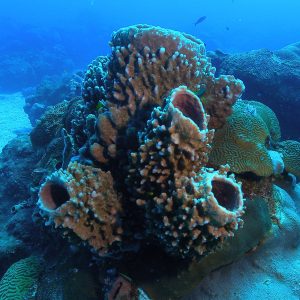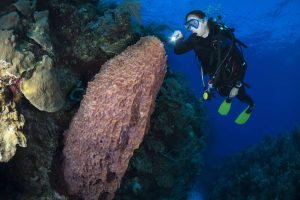A huge amount of the deep sea is still unknown to us. Take a look at some of the bizarre animals that live down there…
Anglerfish
Life can be scarce in the dark depths, which is a problem when animals need to find a partner for mating. Hanging on to a potential mate is a good solution, and some deep-sea anglerfishes take that to extremes.
The males are much smaller than the females, and when boy meets girl, he gives her body a kiss that lasts the rest of his life. The male’s blood supply joins up with the female’s through his lips, and he lives off her like a parasite while she catches prey with her bioluminescent lure. But the dangling male is a handy accessory for the female to carry around, ready to fertilise her eggs when she releases them.
The Squidworm
9 cm (3.5 in) in length and 1 cm (0.39 in) in width.
n the deep sea water column at depths of 2,039 to 2,912 m (6,690 to 9,554 ft).
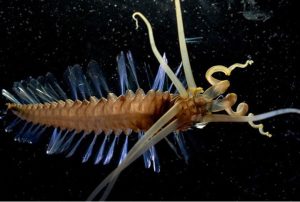
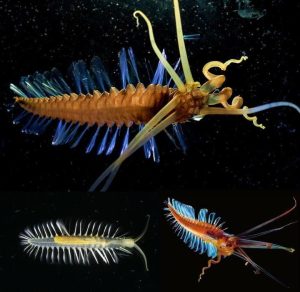
Researchers with the Census of Marine Zooplankton first discovered the squidworm in 2007 during a cruise in a remotely operated vehicle some 1.8 miles underwater. The funky-looking fish is named for the 10 appendages protruding from its head, which look like tentacles.
The squidworm uses these to collect debris falling from the open waters above, known as “marine snow.”
Whitemargin Stargazer
sandy lagoons, silty regions, and coastal waters
up to 45.0 cm maximal length.

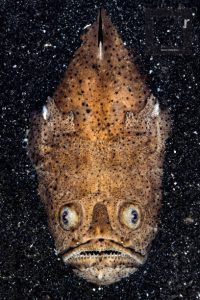
Underwater macro photography taken in Lembeh, Manado – Indonesia.
The Whitemargin stargazer is also known as the pop-eye fish as these curious creatures spend long periods buried with only the eyes and mouth showing until they can catch unsuspecting prey.
Another weird fact about this fish is that it has electric organs in its body, allowing it can fire a deadly 50 volts into its next meal.

Gulper Eel
The gulper eel can vary in length from three to six feet (about one to two meters).
all of the world’s tropical and temperate oceans at depths ranging from 500 to 6,000 feet (about 150 to 1,800 meters).


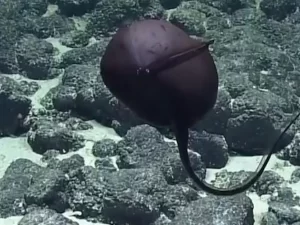
The gulper eel (also referred to as the pelican eel) is named for its massive mouth and jaw, which helps them to swallow prey whole. They can grow up to six feet in length and their huge mouths allow them to hunt down meals that are larger than them. This usually happens when food is scarce—it’s believed that gulper eels usually eat crustaceans and other small marine animals.
Sea Angel
5 centimeters long
Sea angels are found worldwide in cold and temperate waters. They typically live in the midwater zone, from the surface to 2,000 feet deep (600 meters).
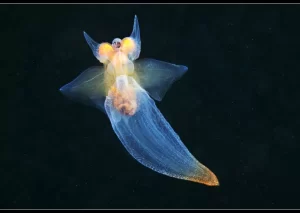
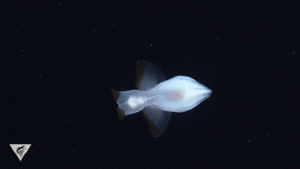
Although they’re called sea angels, these creatures are actually predatory sea snails. This particular specimen, Platybrachium antarcticum, “flies through the deep Antarctic waters hunting the shelled pteropods (another type of snail) on which it feeds,” according to the Marine Census of Life. Sea angels have special parapodia, or lateral extensions of the foot, that help to propel them through the water.
Giant Isopod
16 inches
he deep sea. It can live more than 1600 feet (500m) below the ocean’s surface
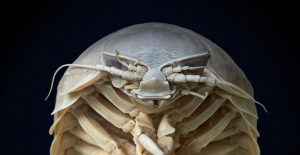
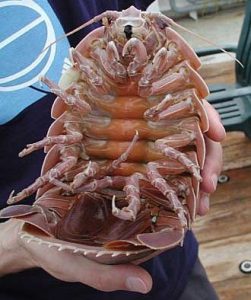
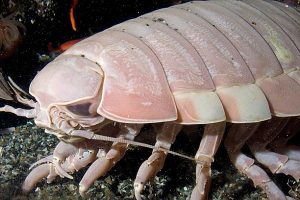
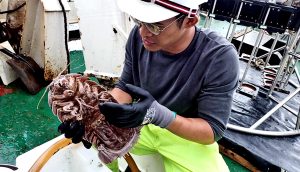
These guys are native to chilly, deep waters and can grow to be quite large; in 2010, a remotely operated underwater vehicle discovered a giant isopod measuring 2.5 feet. These crustaceans, which sort of resemble a massive woodworm, are carnivores and usually feed on dead animals that fall down from the ocean’s surface. Despite their discovery back in 1879, these creatures mostly remain a mystery. However, it’s believed that giant isopods grow so large in order to withstand the pressure at the bottom of the sea.
Box Crab
they range in size from less than 3 to about 6 inches in width.
rocky outcrops and soft, muddy ocean bottoms
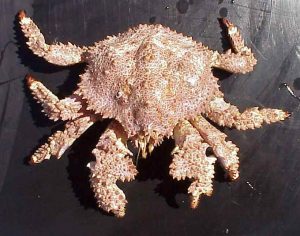

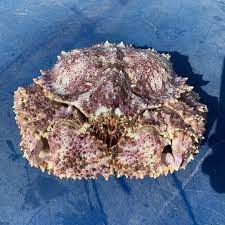
Like so many other sea creatures, the box crab is a master of disguise. In this case, the crustacean—which mostly keeps to the seabed—buries itself beneath the sand, with just its eyes protruding from the mucky depths. One of the most fascinating aspects of the box crab’s life cycle is its mating habits, which literally redefine what it means to be swept off your feet. When the male box crab has found its mate, it grasps onto her with its claws and carries her around the sea floor until she molts her shell.
Christmas Tree Worm
about 1.5 inches in length.
tropical coral reefs around the world
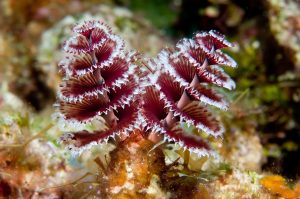

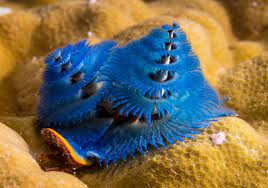
Scientists found this strange creature at the Great Barrier Reef’s Lizard Island and named it, aptly, the Christmas tree worm. The spiral “branches” are actually the worm’s breathing and feeding apparatuses, while the worm itself lives in a tube. These tree-like crowns are covered in hair-like appendages called radioles. These are used for breathing and catching prey, but they can be withdrawn if the Christmas tree worm feels threatened.
Frilled Shark
lengths of nearly 7 feet (2 m)
close to the seabed or in the water column at depths between 500 and 1,000 meters, but may be found as deep as 1,500 meters
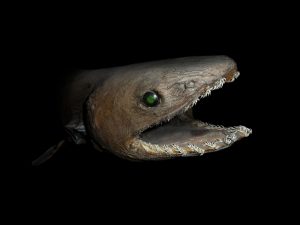
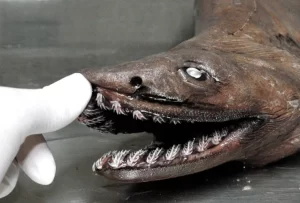
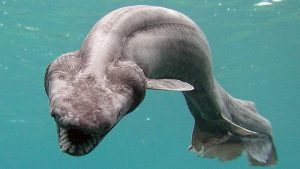
The frilled shark, Chlamydoselachus anguineus, is one of the gnarliest looking creatures in the sea. If it looks like an ancient beast, that’s because it is: the prehistoric creature’s roots go back 80 million years. The frilled shark can grow to about seven feet long and is named for the frilly appearance of its gills. Although shark in name, these animals swim in a distinctly serpentine fashion, much like an eel. They mostly feed on squid, usually swallowing their prey whole.
Ribbon Eel
one meter / 3.3 feet in length
Indo-Pacific ocean
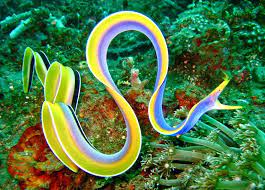
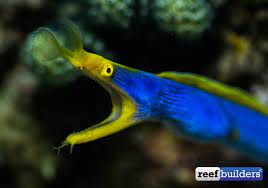
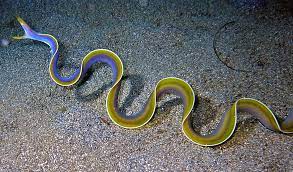
Usually seen nestled into burrows around coral reefs, the ribbon eel (sometimes called the leaf-nosed moray eel) lives in Indonesian waters from East Africa, to southern Japan, Australia, and French Polynesia. The juveniles start out black, with a pale yellow strip along the fins, and as they grow, transitions to a bright blue and yellow coloring. These eels are considered “protrandic hermaphrodites,” meaning they change sex from male to female several times throughout their lives.
Frogfish
The size can range anywhere from 1/8 inch to 22 inches.
Frogfish are found nearly worldwide but tend to be bunched as species in different oceans. This article highlights the frogfish of the info-pacific, found in the genus Antennarius.
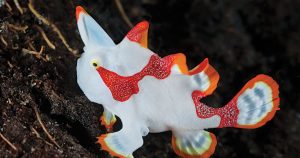


It’s so easy to miss the frogfish, because these types of anglerfish (there are over 50 species of them) are nearly identical to their surroundings—mostly coral reefs. They resemble sponges or algae-covered rocks and come in pretty much every color and texture imaginable. Some frogfish even use their camouflage not to hide, but rather, to mimic poison sea slugs. No matter their appearance, one thing all species of frogfish have in common is their strange mode of locomotion. Although they can swim, most walk along their pectoral fins, which have evolved into arm-like limbs, including a joint that resembles an elbow.
Pink See-Through Fantasia
They are on average 11 to 25 cm in length.
The enypniastes can be found mainly in the benthic zone of the ocean. They can be found all over the globe in many different regions.
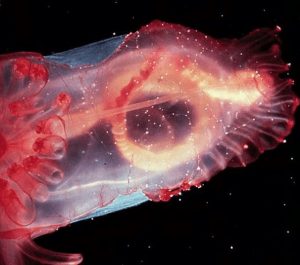
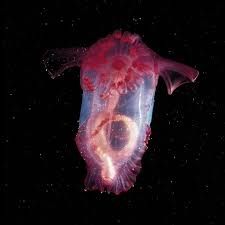
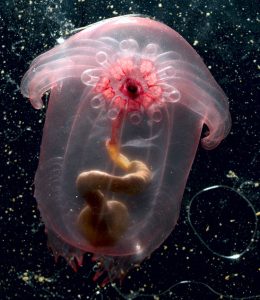
Its name makes it sound like a piece of sexy lingerie, but don’t be fooled: the pink see-through fantasia is a sea cucumber, found about 1.5 miles deep into the Celebes Sea in the western Pacific, east of Borneo. It was only discovered a little over a decade ago, back in 2007, but the curious sea cucumber has a survival tactic that points to its longtime evolution: bioluminescence to ward off predators. The pink see-through fantasia is named for its transparent skin, through which its mouth, anus, and intestines are all visible.
Peacock Mantis Shrimp
2 to 7 inches long
live in shallow parts of the Indian and Pacific Oceans
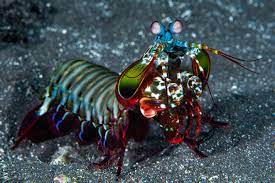
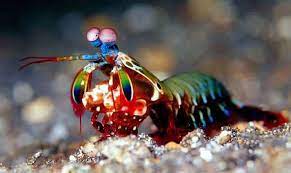
Found in the Indian and tropical western Pacific oceans, the peacock mantis shrimp is a candy-colored crustacean known for its ability to quickly “punch” prey with its front two appendages. According to Oceana, the international ocean preservation advocacy group, this shrimp’s punch is one of the fastest movements in the animal kingdom—so much so, that it’s strong enough to break an aquarium’s glass wall. But no worries: They mostly only use their fists of steel to break open mollusks and dismember crabs.
Marrus Orthocanna
2-3 meters long
pelagically in the mesopelagic zone of the Arctic Ocean, the north west Pacific Ocean, the Bering Sea, the Sea of Okhotsk, the north Atlantic Ocean and the Mediterranean Sea.
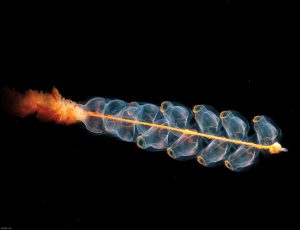
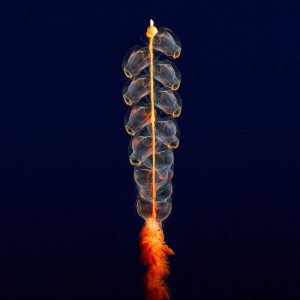
Like a multi-stage rocket, this bizarre microscopic creature, Marrus orthocanna is made up of multiple repeated units, including tentacles and multiple stomachs. Technically, they are physonect siphonophores, which are related to the Portugese man o’war. Like ants, a colony made up of many individuals has attributes resembling a single organism.
Handfish
south eastern Tasmania from the Port Arthur region to Marion Bay including Frederick Henry Bay near Hobart (South Tasmania NRM region).
Handfish grow up to 15 cm
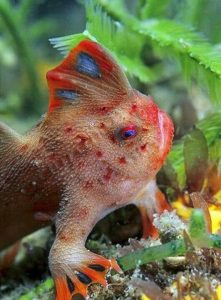
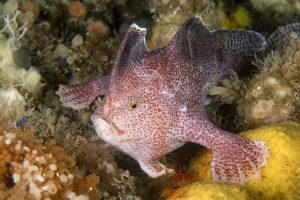
The Handfish is a truly bizarre, bottom-dwelling fish that is most unusual, as it prefers to walk on its pectoral and pelvic fins than swim. The now-endangered fish is native to Australia and five of the eight identified Handfish species are found only in Tasmania and Bass Strait.
Leafy Seadragon
growing to about 20–24 cm
around the southern and western coasts of Australia.
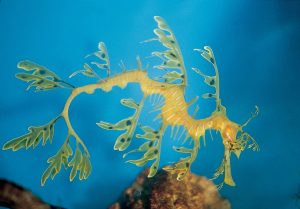

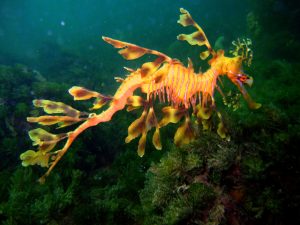
This alien-looking creature’s name is clearly derived from its appearance, with long leaf-like protrusions seeming to sprout from all over the body.
Lionfish
They grow to about 12-15 inches in length
coral reefs in the tropical waters of the South Pacific and Indian Oceans.
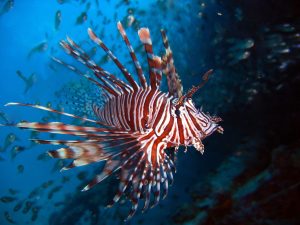
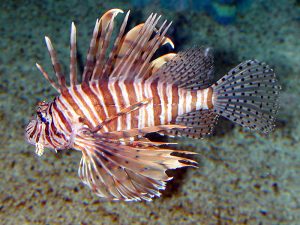
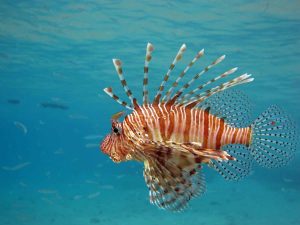
Boxfish
three to 16 inches
on coral reefs in the Pacific and Indian Oceans as well as the southeastern Atlantic Ocean.

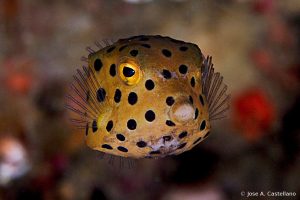
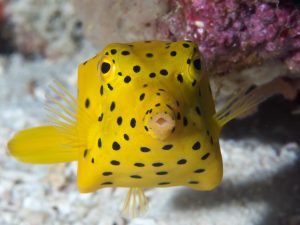
Psychedelic Frogfish
Individuals can grow to 8.7 cm.
in the restricted areas of the Ambon and the Molucca islands in Indonesia.
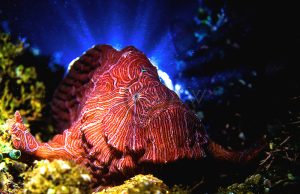
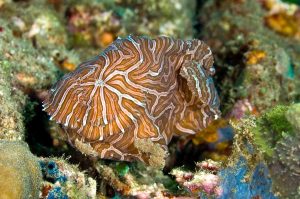
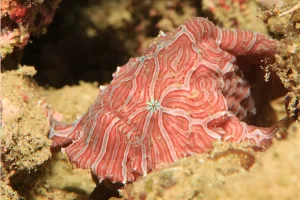
Nudibranch
anywhere from a quarter of an inch to 12 inches long and can weigh up to 3.3 pounds.
They are found throughout the world’s oceans, but are most abundant in shallow, tropical waters.
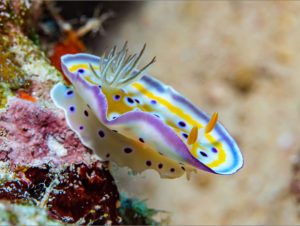
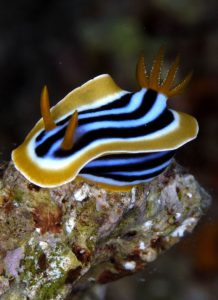
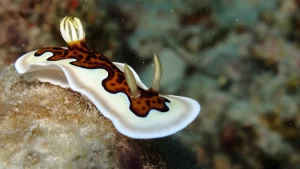
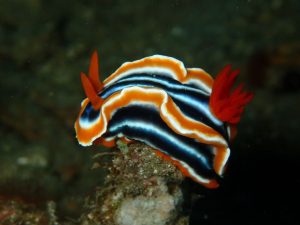
Giant Barrel Sponge
can reach maximum diameters of six feet and can grow to heights of nearly eight feet.
found in the Caribbean and the Gulf of Mexico, most commonly on coral reefs.
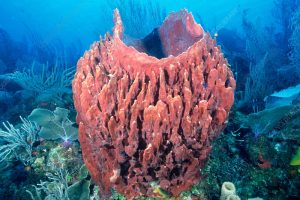
Immortal Jellyfish
only about 4.5 mm
Immortal jellyfish are thought to have originated in the Mediterranean Sea, however they are now found in oceans all around the world.
